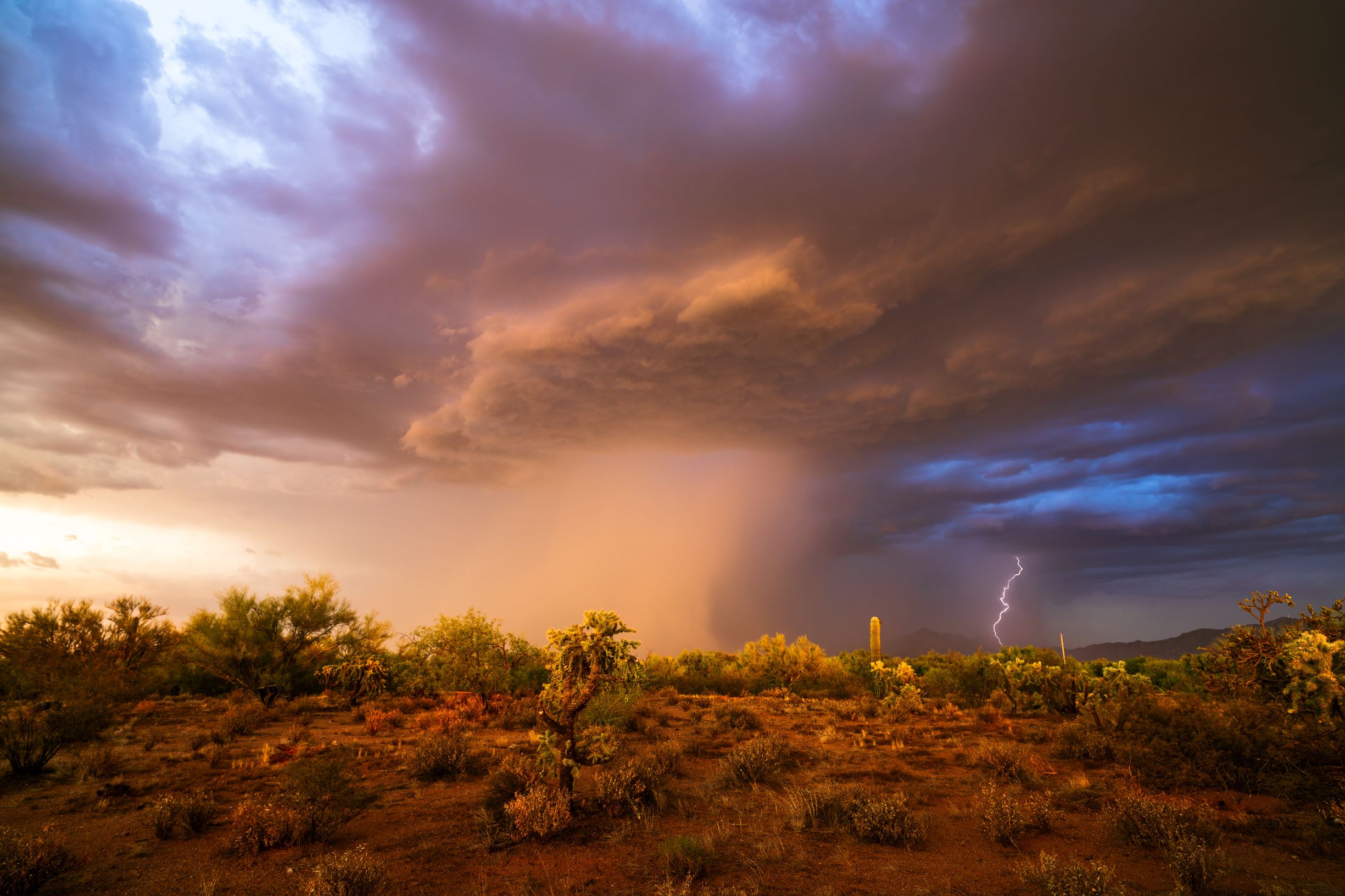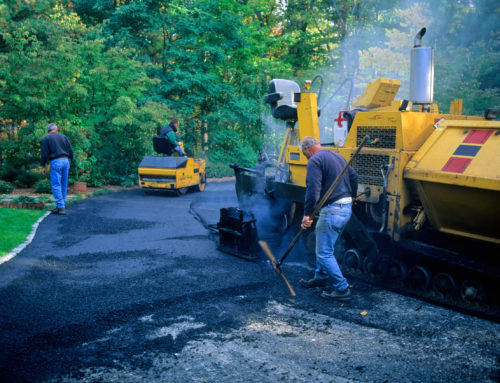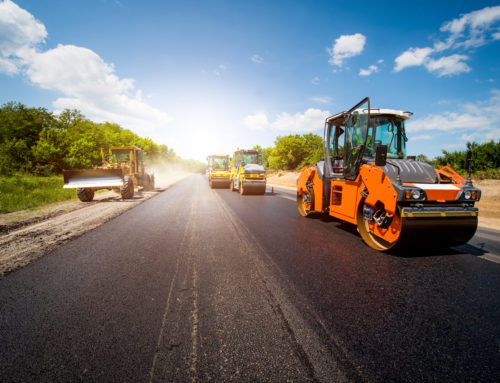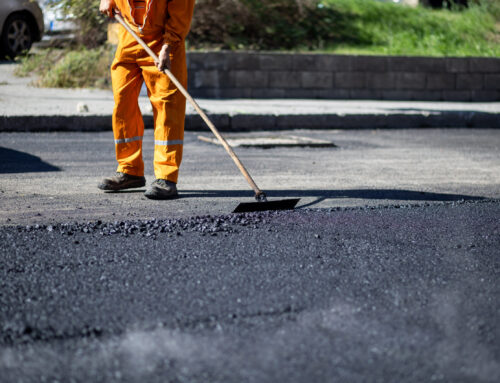We’re deep into the summer and anyone who has been in Arizona for long knows that means monsoon season is here! This time on the Sunrise Asphalt blog we’re going to take a slightly different approach from our asphalt focus and give you the info you need to drive on asphalt safely these next few months. It’s monsoon safety time!
What are Monsoons?
Not familiar with the term or just recently move to Arizona? Here’s the skinny on monsoons. Monsoons are storms and weather patterns marked by higher humidity, heavy rain, thunderstorms, dust storms, flash flooding and of course, heat. It’s technically the name for the changing wind patterns, when winds out of the south bring more moisture up to Arizona. Even more technically Arizona sits as the northern reach of the North American Monsoon. It begins in mid-June and runs til the end of September.
How that looks for us practically is that during the day the increased heat builds storms, creating more powerful winds. The storms then coming crash in the evening, letting out with their rain and thunder. The next day dawns with fair weather as the storm has passed but the heat and moisture start the process all over again. Along with the rain comes powerful winds that create dust storms or the ‘haboob’ as they are sometimes called.
Monsoon Safety Driving Tips
- Be like the Boy Scouts: Be Prepared – Keep an emergency kit in your car filled with things like drinking water, an external cell phone battery charger, etc. Find out more about what to include in an emergency kit here.
- Feeling Doubt? Don’t Go Out! – Does the weather look like its about to turn? See a dust storm on the horizon? Don’t chance it, wait for the weather to pass. If you’re already on the road find a safe place to park and wait it out. Note: Get off the roadway if possible! Sitting along side the highway in a dust storm in low visibility can be even more dangerous.
- In a Low or Zero Visibility Situation? – Pull your vehicle off the road, going as far to the right as possible. You might think having your foot on the brake is a good idea, to prevent you from going anywhere but when your foot is on the brake your brake lights are lit up. This can confuse driver behind you thinking that your vehicle is moving. So avoid this by turning off your lights, setting the parking brake, and taking your foot off the brake pedal. These steps reduce the chances that other drivers mistake your vehicle as the one to follow.
- Don’t Cross a Wash – Part of the risk of monsoons is flash flooding! A wash is any sort of dried out creek bed or stream, and while it might have some flooding and you think its shallow, the truth is that even a few inches of water can be a powerful force. Don’t risk it, look for safer, dry places to cross.
- Follow the Signs – See a Road Closed sign blocking your route? Don’t drive around it! There’s a good reason it’s closed and you may be risking your life ignoring it. Not mention Arizona will slap you with the Stupid Motorist Law! Don’t be stupid, be smart!
- Four Way Stops – In storms it’s not uncommon for traffic lights to go out. If this happens, treat every intersection like a four-way stop and go appropriatelyIf traffic lights are out, treat an intersection just like a four-way stop.
- Stay Alert! – No matter where you’re driving, stay alert! The storm run off can loosen rocks and boulders surrounding slopes and roads. Be cautious in areas prone to falling stones.
Driving in Heavy Rains
Dust storms aren’t the only worry when it comes to monsoons. The heavy rains can also leave plenty of water behind on the roads to be cautious of. Be cautious of hydroplaning.When there is even a thin layer of water on the road and it sits between asphalt and your tires your vehicle loses it’s contact with the road and thus it’s grip. You might suddenly feel your vehicle sliding or drifting. That’s because you’ve lost your traction!
Uh Oh, I’m Hydroplaning. Now What!
First of all, boy don’t try to read on your phone while driving! Alright, with that out of the way, iIf you feel you are hydroplaning, ease your foot off the gas pedal until you regain traction. Do not brake suddenly. If you are sliding or drifting, gently turn your steering wheel in the direction of your slide.
Here are some general tips when it comes to driving in the rain and wet roads.
- Before you drive, inspect your windshield wipers, replacing if necessary.
- Turn on your headlights while driving to increase your visibility and visibility of you.
- Reduce your speed! Maintaining a further, safe distance between your vehicle and the one in front of you and create a space cushion.
- Speaking of space cushions, this is especially true of larger vehicles. The tires of larger vehicles create a spray of water that decreases visibility – so don’t follow them too closely.
- When driving on wet roads, avoid sudden braking. This can cause you to slide on the wet pavement. Instead, take your foot off the gas and brake slowly to slow down at a safer pace.
- Avoid pooling water. Use center lanes (roads are built in such a way that they crown and should have water running off. Also, drive in the tracks of the vehicle ahead of you.
We hope you don’t end up needing these tips and your drives are smooth these next few months. Remember to slow down, drive safe, and be vigilant. Those tips will serve you well year-round.





